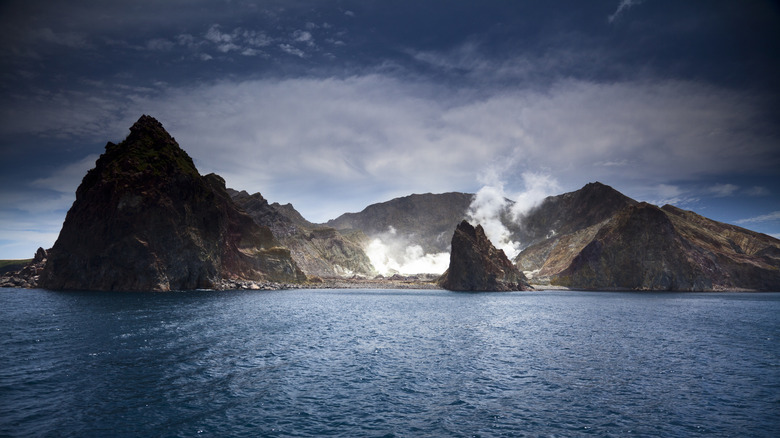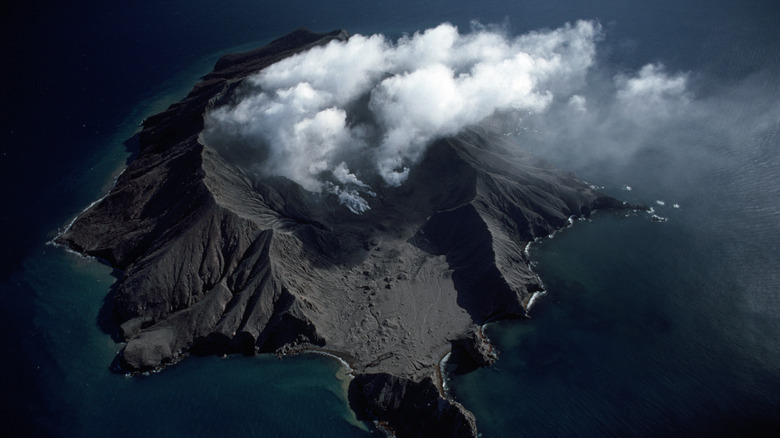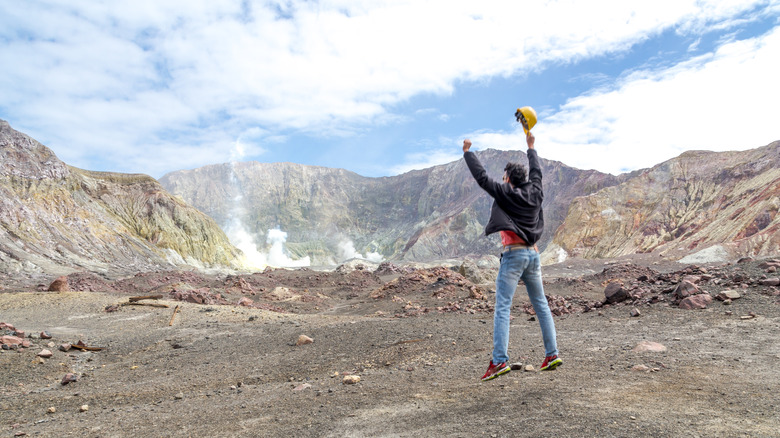New Zealand Is Home To One Of The World's Most Dangerous Islands With An Active Volcano
Despite its frequent exclusions from world maps, New Zealand is one of the world's most attractive tourist destinations from year to year. With a remarkable combination of soaring mountains, gorgeous coastlines, and a unique cultural heritage, New Zealand frequently ranks as one of the most beautiful countries on Earth. Add a notable pop culture claim to fame with the country's "Lord of the Rings" connection, and you get a wonderful vacation destination for all sorts of travelers.
But New Zealand's outer beauty hides a darker secret just under the surface. The islands that comprise New Zealand lie within the "Pacific Ring of Fire," a large belt of tectonic subduction zones that circumnavigates much of the Pacific Ocean, and which experiences frequent volcanic activity and earthquakes. New Zealand's volcanic geological heritage is still quite evident across its landscape today, particularly in the numerous active volcanoes that still dot the country (including the terrifying supervolcano that sits underneath New Zealand's Lake Taupō).
However, one of New Zealand's most dangerous volcanoes is not found on the mainland at all, but lies just off the coast of its North Island. Though small, the volcanic island known alternatively as "Whakaari," or "White Island," is one of the most active volcanoes in New Zealand and one of the world's most dangerous islands. Though it offers a unique breed of terrifying beauty, Whakaari has also been the site of recent tragedies that currently make it off limits for tourists.
Whakaari/White Island has already claimed the lives of tourists
Whakaari/White Island is located in the Bay of Plenty, off the northeastern coast of New Zealand's North Island. Though barely visible on a map, Whakaari is one of the most geologically active spots in New Zealand. The entire island is an active stratovolcano, one that has been consistently emitting large amounts of steam and volcanic gases for decades. This kind of geological activity is one of the many distinctive features that leads to New Zealand's status as a potential "eighth continent," and one of the world's top tourist destinations. But as impressive as this volcanic activity is to watch, it has tragically proven to be quite dangerous.
For years, Whakaari was a major tourist attraction in New Zealand's North Island. Not only would tourism companies lead boat tours to the island, they'd even allow tourists to explore the island on foot. Despite consistent steam and gas emissions, tourists were never warned about potential dangers, and island visits went on without incident.
All that changed in 2019, however. On December 9, the island's volcano came violently to life in an explosive phreatic eruption, a type of volcanic eruption consisting mainly of steam and extremely hot volcanic gases. Though this eruption was relatively small compared to some of history's most infamous eruptions, it unfortunately coincided with several tour group visits, many of whom were caught in the deadly blast of steam and gases. Tragically, 22 people lost their lives, and an additional 25 suffered severe injuries. Subsequent investigations and litigation revealed numerous ignored warning signs and safety precautions. Many of the touring companies involved were hit with both criminal and civil liability, and all trips to Whakaari have been indefinitely suspended.
How to (safely) experience Whakaari's terrifying beauty
Though access to the island itself is currently restricted, you can still witness Whakaari's dangerous beauty from a safe distance. Local tourism firms currently offer scenic flight tours of Whakaari Island and many other nearby attractions (including Mount Tarawera, Ruapehu, and the Coromandel Peninsula). The waters surrounding Whakaari are also top spots for fishing, and numerous boat operators run charter fishing trips that can take you close enough to the island to get a good view (while still being far enough away to stay out of danger in the event of another eruption). Even if you're not keen on paying for a chartered flight or fishing trip, Whakaari is also close enough to shore to be visible from the North Island town of Whakatāne. On active days, you can even see the volcano's ominous clouds of smoke and steam from the town's beaches!
And even with its most active volcano currently off-limits, New Zealand still has plenty of amazing volcano destinations to thrill aspiring volcanologists. On New Zealand's North Island alone, you can hike to the top of a live volcano at Tongariro National Park or take a scenic boat tour over a massive volcanic caldera at Lake Taupō. Still, the 2019 tragedy at Whakaari/White Island is a sobering reminder that the Earth's surface is never static, but is constantly (and sometimes violently) changing.


